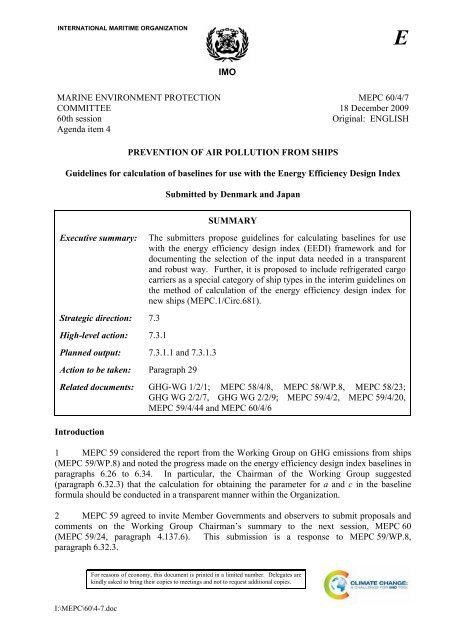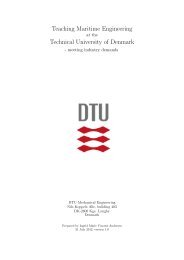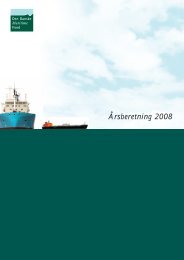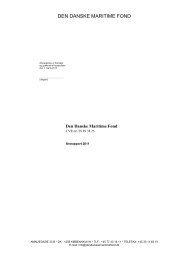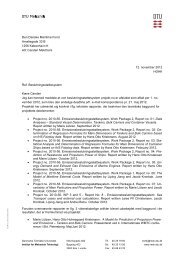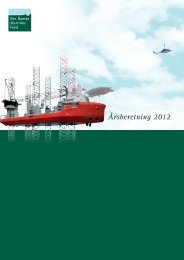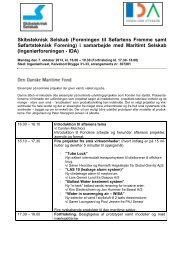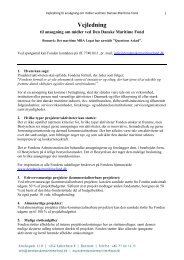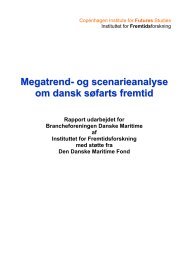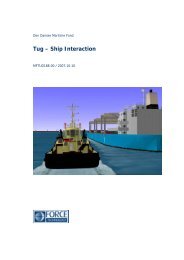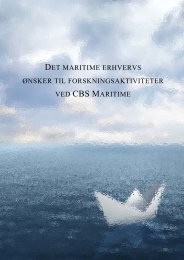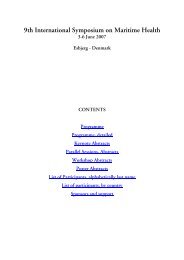IMO MARINE ENVIRONMENT PROTECTION COMMITTEE 60th ...
IMO MARINE ENVIRONMENT PROTECTION COMMITTEE 60th ...
IMO MARINE ENVIRONMENT PROTECTION COMMITTEE 60th ...
Create successful ePaper yourself
Turn your PDF publications into a flip-book with our unique Google optimized e-Paper software.
INTERNATIONAL MARITIME ORGANIZATION<br />
E<br />
<strong>IMO</strong><br />
<strong>MARINE</strong> <strong>ENVIRONMENT</strong> <strong>PROTECTION</strong><br />
<strong>COMMITTEE</strong><br />
<strong>60th</strong> session<br />
Agenda item 4<br />
MEPC 60/4/7<br />
18 December 2009<br />
Original: ENGLISH<br />
PREVENTION OF AIR POLLUTION FROM SHIPS<br />
Guidelines for calculation of baselines for use with the Energy Efficiency Design Index<br />
Submitted by Denmark and Japan<br />
Executive summary:<br />
Strategic direction: 7.3<br />
High-level action: 7.3.1<br />
Planned output: 7.3.1.1 and 7.3.1.3<br />
Action to be taken: Paragraph 29<br />
SUMMARY<br />
The submitters propose guidelines for calculating baselines for use<br />
with the energy efficiency design index (EEDI) framework and for<br />
documenting the selection of the input data needed in a transparent<br />
and robust way. Further, it is proposed to include refrigerated cargo<br />
carriers as a special category of ship types in the interim guidelines on<br />
the method of calculation of the energy efficiency design index for<br />
new ships (MEPC.1/Circ.681).<br />
Related documents: GHG-WG 1/2/1; MEPC 58/4/8, MEPC 58/WP.8, MEPC 58/23;<br />
GHG WG 2/2/7, GHG WG 2/2/9; MEPC 59/4/2, MEPC 59/4/20,<br />
MEPC 59/4/44 and MEPC 60/4/6<br />
Introduction<br />
1 MEPC 59 considered the report from the Working Group on GHG emissions from ships<br />
(MEPC 59/WP.8) and noted the progress made on the energy efficiency design index baselines in<br />
paragraphs 6.26 to 6.34. In particular, the Chairman of the Working Group suggested<br />
(paragraph 6.32.3) that the calculation for obtaining the parameter for a and c in the baseline<br />
formula should be conducted in a transparent manner within the Organization.<br />
2 MEPC 59 agreed to invite Member Governments and observers to submit proposals and<br />
comments on the Working Group Chairman’s summary to the next session, MEPC 60<br />
(MEPC 59/24, paragraph 4.137.6). This submission is a response to MEPC 59/WP.8,<br />
paragraph 6.32.3.<br />
For reasons of economy, this document is printed in a limited number. Delegates are<br />
kindly asked to bring their copies to meetings and not to request additional copies.<br />
I:\MEPC\60\4-7.doc
MEPC 60/4/7 - 2 -<br />
Objective<br />
3 The objective of this proposal is to define the procedure for calculating baselines for use<br />
with the energy efficiency design index (EEDI) framework and to document the selection of<br />
input data needed. The purpose of the EEDI is to provide a fair basis for comparison, to stimulate<br />
the development of more efficient engines and ships in general, and to establish the minimum<br />
efficiency of new ships depending on ship type and ship size. Hence, a transparent and robust<br />
procedure for calculating baselines needs to be established. Further, the objective is to establish<br />
a special category of ship types for refrigerated cargo carriers in the annex to MEPC.1/Circ.681.<br />
Definition of a baseline<br />
4 For this purpose, a baseline is defined as a line representing an average index value fitted<br />
on a set of individual index values for a defined group of vessels. One baseline will be<br />
developed for each ship type ensuring that only data from comparable existing ships are included<br />
in the calculation of the baseline.<br />
5 The average index value is a function of Capacity and formulated as a power law<br />
−c<br />
regression curve expressed as Baseline value = a ⋅Capacity<br />
, where a and c are constants<br />
determined from the regression curve fit.<br />
6 The group of vessels used for determining the average index value per ship type is<br />
defined as the vessels built in a defined period and with data points more than two standard<br />
deviations beyond the regression curve removed.<br />
Data sources and access<br />
7 Lloyd’s Register Fairplay (LRFP) database is proposed as the database delivering the<br />
primary input data for the baseline calculation. The data, which are typically provided by<br />
shipyards, are consolidated by LRFP, taking into account data from other sources such as IACS,<br />
owners, and engine manufacturers.<br />
8 The LRFP data available to subscribers are continuously updated and possible different<br />
versions of the database are in parallel use. Therefore, different data sets may be used by different<br />
organizations or the data may be dependent on the date of their retrieval. For the purpose of the<br />
EEDI baseline calculations, a defined version of the database should be documented and agreed<br />
with LRFP.<br />
Database robustness<br />
9 The robustness of the data in the LRFP database has been debated. The attained EEDI<br />
should be calculated in a specific EEDI condition at 75% main engine loading and in calm<br />
weather, but the data in the database (service speed, deadweight and main engine power) may<br />
reflect a slightly different condition – especially for container ships which should be evaluated<br />
at 65% of the maximum deadweight.<br />
10 To investigate this, an analysis was carried out for 170 container ships and 11 ro-ro cargo<br />
ships, which were not more than 10 years old. Original data from model tests, full-scale<br />
observations on board or sea trials were available from the yard or the owner and converted to<br />
the EEDI condition by the Technical University of Denmark using standard power prediction<br />
methods common in naval architecture. On this basis one EEDI value was calculated for each<br />
I:\MEPC\60\4-7.doc
- 3 - MEPC 60/4/7<br />
ship according to the methodology described in MEPC.1/Circ.681. This EEDI was then<br />
compared to another EEDI calculated for the same ship according to the same methodology but<br />
this time based on the data in the LRFP database.<br />
11 The analysis showed the following:<br />
.1 The mean EEDI was 2.6% lower for container ships and 5.4% higher for ro-ro<br />
cargo ships when using the LRFP database compared to using original data.<br />
.2 The service speed in the LRFP database was on average 1.3% higher than the<br />
speed at 65% deadweight and 75% main engine power for container ships.<br />
.3 The service speed in the LRFP database was on average 0.5% higher than the<br />
speed at 100% deadweight and 75 % engine power for ro-ro cargo ships.<br />
.4 The main engine power in the LRFP database was on average 1.6% lower for<br />
container ships and 0.2% lower for ro-ro cargo ships.<br />
.5 For one container ship and two ro-ro cargo ships, the deadweight in the<br />
LRFP database deviated more than 10% from the correct deadweight. This error<br />
in the deadweight did not affect the average EEDI due to the large population of<br />
container ships. However, due to the small population of ro-ro cargo ships the<br />
average EEDI was heavily affected by the error in deadweight. Without this error<br />
the 5.4% mentioned above would have been only 1.5%. However, it should be<br />
kept in mind that the small population was a result of the fact that there were only<br />
original data available for 11 ro-ro cargo ships.<br />
12 From the above analysis it is concluded that an accurate baseline can be established using<br />
data from the LRFP database – also for container ships evaluated at 65% deadweight without<br />
adjustment of the reported service speed.<br />
Selection of input data<br />
13 At MEPC 59, the Working Group on GHG emissions from ships agreed that the data used<br />
should be those on new buildings in the recent 10 years, and outliers which are more than two<br />
standard deviations from the regression line should be removed before a new regression line is<br />
calculated.<br />
Ship types<br />
14 In the annex to MEPC.1/Circ.681, Interim guidelines on the method of calculation of the<br />
energy efficiency design index, paragraph 1, the following ship types are defined: Passenger<br />
ship, dry cargo carrier, gas tanker, tanker, containership, ro-ro cargo ship vehicle carrier<br />
(a multi-deck ro-ro cargo ship designed for the carriage of empty cars and trucks), ro-ro cargo<br />
ship volume carrier (a ro-ro cargo ship with a deadweight per lane metre less than 4 tons/m<br />
designed for the carriage of cargo transportation units), ro-ro cargo ship weight carrier (a ro-ro<br />
cargo ship with a deadweight per lane metre of 4 tons/m or above designed for the carriage of<br />
cargo transportation units), general cargo ship and ro-ro passenger ship.<br />
15 The annex to MEPC.1/Circ.681, paragraph 2, includes the note that “this formula may not<br />
be able to apply to diesel-electric propulsion, turbine propulsion or hybrid propulsion system”.<br />
It should be noted that a large number of gas tankers, in particular LNG carriers, have steam<br />
I:\MEPC\60\4-7.doc
MEPC 60/4/7 - 4 -<br />
turbine main engines. Therefore, in obtaining the baseline for gas tankers, steam turbine ships in<br />
LRFP should be excluded from the input data in order to keep consistency with the annex to<br />
MEPC.1/Circ.681.<br />
16 Refrigerated cargo carriers, which would be categorized as general cargo ships if the<br />
present categories in the annex to MEPC.1/Circ.681 are followed, should be treated as a separate<br />
ship type. Refrigerated cargo carriers generally navigate at a higher speed than general cargo<br />
ships due to the service requirement to reduce the transport time of fresh foods, thus making their<br />
baseline deviate considerably from the baseline for general cargo ships. A rationale for such a<br />
separate ship category is provided in annex 2 to this document.<br />
17 To ensure a uniform interpretation, a table presenting the association of ship types given in<br />
the annex to MEPC.1/Circ.681 compared to the ship types given by the LRFP Stat codes is shown<br />
in annex 1 to this document. Table 2 in annex 1 lists the LRFP ship types which clearly should not<br />
be used when calculating the baselines for the specific ship types in the annex to MEPC.1/Circ.681,<br />
e.g., ships built for sailing on the Great Lakes, bulk/oil carrier (OBO), landing craft.<br />
Blank data entries<br />
18 For some LRFP ships, some data entries may be blank or contain a zero (0). Datasets<br />
with blank power, capacity and/or speed data should be removed from the baseline calculations.<br />
For the purpose of later references, the omitted ships should be listed.<br />
Speed<br />
19 The definition of speed in the annex to MEPC.1/Circ.681 is: “V ref is the speed, measured in<br />
nautical miles per hour (knot), on deep water in the maximum design load condition (Capacity)<br />
as defined in paragraph 3 at the shaft power of the engine(s) as defined in paragraph 5 and<br />
assuming the weather is calm with no wind and no waves. The maximum design load condition<br />
shall be defined by the deepest draught with its associated trim, at which the ship is allowed to<br />
operate. The condition is obtained from the stability booklet approved by the Administration.”.<br />
20 The condition for the LRFP service speed information is not clear. Normally, the service<br />
speed of a ship is given at 85-90% MCR combined with a sea margin of 10-15%. This was<br />
indeed the rationale for defining the power (P ME(I) ) for calculation of the attained index as 75% of<br />
the rated installed power (MCR). Accordingly the service speed information in LRFP will be the<br />
most accurate speed to use as V ref when computing average index values and baselines.<br />
Capacity<br />
21 The capacity for each ship type is defined in the annex to MEPC.1/Circ.681.<br />
Installed power<br />
22 The installed main power P ME(i) and the required auxiliary power P AE are defined in the<br />
annex to MEPC.1/Circ.681. For cargo ships with a main engine power of 10,000 kW or above,<br />
the P AE should be calculated according to paragraph 2.5.6.1, and for cargo ships with a main<br />
engine power below 10,000 kW, the P AE should be calculated according to paragraph 2.5.6.2.<br />
For passenger ships with conventional propulsion systems, the P AE value should be estimated by<br />
the consumed electric power (excluding propulsion) in conditions when the ship is engaged in a<br />
voyage at reference speed (V ref .) as given in the electrical power table divided by the weighted<br />
average efficiency of the generator(s).<br />
I:\MEPC\60\4-7.doc
- 5 - MEPC 60/4/7<br />
23 Information on the P AE value for passenger ships with conventional propulsion is not<br />
available in the LRFP database. In order to establish a baseline for these ships, the factor on the<br />
relation between the electric load at normal sea load according to the ship’s power balance and<br />
the total installed auxiliary power has been calculated for a number of existing ships. The<br />
average of these factors is rounded off to the nearest figure that can be divided by 5. This factor<br />
divided by 100 is 0.35 and this is proposed to be multiplied by the information on the total<br />
installed auxiliary power in the LRFP database when calculating the baseline for conventionally<br />
driven passenger ships and ro-ro passenger ships (see annex 3).<br />
Assumptions for index formula input parameters<br />
24 As all the data required to calculate the exact index value for each ship cannot be obtained<br />
from the LRFP database, such as the fuel used, the specific fuel consumption, waste heat<br />
recovery, etc., the following assumptions should be made:<br />
.1 the carbon emission factor is constant for all engines, i.e. C F,ME = C F,AE = CF =<br />
3.1144 g CO 2 /g fuel;<br />
.2 the specific fuel consumption for all ship types is constant for all main<br />
engines, i.e. SFC ME = 190 g/kWh.;<br />
.3 P ME(I) is 75% of the rated installed power (MCR) for each main engine without<br />
any deduction for shaft generators;<br />
.4 the specific fuel consumption for all ship types is constant for all auxiliary<br />
engines, i.e. SFC AE = 215 g/kWh.;<br />
.5 P AE is the installed auxiliary power and for cargo ships it is calculated according<br />
to paragraphs 2.5.6.1 and 2.5.6.2 of the annex in MEPC.1/Circ.681.<br />
For passenger ships P AE is calculated as the total installed auxiliary power<br />
according to the information in the LRFP database multiplied by 0.35;<br />
.6 all correction factors f j, f i and f w are set to 1; and<br />
.7 innovative mechanical energy efficiency technology, shaft motors and other<br />
innovative energy efficient technologies are all excluded from the baseline<br />
calculation, i.e. P AEeff = 0, P PTI = 0, P eff = 0.<br />
25 The equation for calculating the estimated index value is then as follows:<br />
Estimated<br />
Index Value =<br />
3 .11<br />
NME<br />
∑<br />
190 ⋅ PMEi<br />
+ 215⋅<br />
P<br />
i=1<br />
⋅<br />
Capacity ⋅V<br />
ref<br />
AE<br />
Proposal<br />
26 It is proposed that the baselines for the different ship types defined in the annex to<br />
MEPC.1/Circ.681, with an additional ship type category definition for refrigerated cargo carriers,<br />
are calculated based on the formula in paragraph 25 and the information on the relevant ship type<br />
from the LRFP database on new buildings in the period from 1 January 1999 to 1 January 2009.<br />
I:\MEPC\60\4-7.doc
MEPC 60/4/7 - 6 -<br />
27 When calculating the baselines, the following modifications should be used:<br />
.1 passenger ships and ro-ro passenger ships with a reference speed below 15 knots<br />
should be removed from the calculations (as done so far); and<br />
.2 it is further proposed to align guidelines for calculation of baselines for use with<br />
the EEDI with possible submissions on the recalculated EEDI baseline for<br />
container ships and on ro-ro cargo ships subgroups as described in document<br />
MEPC 60/4/6.<br />
Documentation<br />
28 For purposes of transparency, the ships used in the calculation of the baselines should be<br />
listed with their <strong>IMO</strong> numbers and the nominator and denominator of the index formula, as given<br />
in paragraph 25. The documentation of the aggregated figures preserves the individual data from<br />
direct access but offers sufficient information for possible later scrutiny.<br />
Action requested of the Committee<br />
29 The Committee is invited to consider the proposal and take action as appropriate.<br />
***<br />
I:\MEPC\60\4-7.doc
MEPC 60/4/7<br />
ANNEX 1<br />
To ensure a uniform interpretation, the association of ship types given in MEPC.1/Circ.681 must<br />
be compared to the ship types given in the Lloyds Register Fairplay database (LRFP).<br />
The LRFP Stat code system provides several levels of definition as follows:<br />
Highest level:<br />
A<br />
B<br />
W<br />
X<br />
Y<br />
Z<br />
Cargo carrying<br />
Work vessel<br />
Non-seagoing merchant ships<br />
Non-merchant<br />
Non-propelled<br />
Non-ship structures<br />
For the purpose of the EEDI, only group “A cargo carrying” needs to be considered. A graphical<br />
representation of this is given below.<br />
The next level comprises:<br />
A1<br />
A2<br />
A3<br />
Tankers<br />
Bulk carriers<br />
Dry cargo/passenger<br />
There are further differentiations until level five, e.g., “A31A2GX General Cargo Ship”, and<br />
each category is described.<br />
The complete list is attached.<br />
I:\MEPC\60\4-7.doc
MEPC 60/4/7<br />
ANNEX 1<br />
Page 2<br />
The ship types from the LRFP Stat code 5 (Statcode5v1075) that are proposed to be used for the<br />
calculation of baselines for the ship types given in MEPC.1/Circ.681 are set out in Table 1 and<br />
the LRFP ship types which clearly should not be used in the calculations for the specific ship<br />
types are set out in Table 2, e.g., ships built for sailing on the Great Lakes, bulk/oil carrier<br />
(OBO), landing craft.<br />
Table 1 – Ship types from LRFP to be used for the calculation of baselines for use<br />
with the EEDI<br />
.1 Passenger<br />
ship<br />
.2 Dry cargo<br />
carrier<br />
I:\MEPC\60\4-7.doc<br />
Passenger A37B2PS Passenger ship A vessel certificated to carry more than<br />
12 passengers, some of whom may be<br />
accommodated in cabins.<br />
Passenger A37A2PC Passenger/<br />
cruise<br />
A vessel certificated to carry more than<br />
12 passengers, all of whom may be<br />
accommodated in cabins.<br />
Bulk dry A21A2BC Bulk carrier A single deck cargo vessel with an arrangement<br />
of topside ballast tanks for the carriage of bulk<br />
dry cargo of a homogeneous nature.<br />
Bulk dry A21B2BO Ore carrier A single deck cargo ship fitted with two<br />
longitudinal bulkheads. Ore is carried in the<br />
centreline holds only.<br />
Selfdischarging<br />
bulk dry<br />
Other<br />
bulk<br />
.3 Gas tanker Liquefied<br />
gas<br />
dry<br />
A23A2BD Bulk cargo<br />
carrier,<br />
self-discharging<br />
A bulk carrier fitted with self-trimming holds, a<br />
conveyor belt (or similar system) and a boom<br />
which can discharge cargo alongside or to shore<br />
without the assistance of any external equipment.<br />
A24A2BT Cement carrier A single deck cargo vessel fitted with pumping<br />
arrangements for the carriage of cement in bulk.<br />
There are no weather deck hatches. May be<br />
self-discharging.<br />
A24B2BW Wood chips<br />
carrier,<br />
self-unloading<br />
A single deck cargo vessel with high freeboard<br />
for the carriage of wood chips. May be<br />
self-discharging.<br />
A24C2BU Urea carrier A single deck cargo vessel for the carriage of<br />
A24D2BA<br />
A24E2BL<br />
Aggregates<br />
carrier<br />
Limestone<br />
carrier<br />
urea in bulk. May be self-discharging.<br />
A single deck cargo vessel for the carriage of<br />
aggregates in bulk. Also known as a sand<br />
carrier. May be self-discharging.<br />
A single deck cargo vessel for the carriage of<br />
limestone in bulk. There are no weather deck<br />
hatches. May be self-discharging.<br />
A11A2TN LNG tanker A tanker for the bulk carriage of liquefied<br />
natural gas (primarily methane) in independent<br />
insulated tanks. Liquefaction is achieved at<br />
temperatures down to -163 deg C.<br />
A11B2TG LPG tanker A tanker for the bulk carriage of liquefied<br />
petroleum gas in insulated tanks, which may be<br />
independent or integral. The cargo is pressurized<br />
(smaller vessels), refrigerated (larger vessels) or<br />
both (“semi-pressurized”) to achieve liquefaction.<br />
A11C2LC CO 2 tanker A tanker for the bulk carriage of liquefied<br />
carbon dioxide.<br />
A11A2TQ CNG tanker A tanker for the bulk carriage of compressed<br />
natural gas. Cargo remains in gaseous state but<br />
is highly compressed.
MEPC 60/4/7<br />
ANNEX 1<br />
Page 3<br />
.4 Tanker<br />
Chemical<br />
Oil<br />
Other<br />
liquids<br />
A12A2LP<br />
A12A2TC<br />
A12B2TR<br />
Molten sulphur<br />
tanker<br />
Chemical<br />
tanker<br />
Chemical/<br />
products<br />
tanker<br />
A tanker for the bulk carriage of molten sulphur<br />
in insulated tanks at a high temperature.<br />
A tanker for the bulk carriage of chemical<br />
cargoes, lube oils, vegetable/animal oils and<br />
other chemicals as defined in the International<br />
Bulk Chemical Code. Tanks are coated with<br />
suitable materials which are inert to the cargo.<br />
A chemical tanker additionally capable of the<br />
carriage of clean petroleum products.<br />
A12C2LW Wine tanker A cargo ship designed for the bulk transport of<br />
wine in tanks. Tanks will be stainless steel or<br />
lined. New vessels will be classified as<br />
chemical carriers.<br />
A12D2LV Vegetable oil<br />
tanker<br />
A12E2LE<br />
Edible oil<br />
tanker<br />
A cargo ship designed for the bulk transport of<br />
vegetable oils in tanks. Tanks will be stainless<br />
steel or lined. New vessels will be classified as<br />
chemical carriers.<br />
A cargo ship designed for the bulk transport of<br />
edible oils in tanks. Tanks will be stainless steel<br />
or lined. New vessels will be classified as<br />
chemical carriers.<br />
A12F2LB Beer tanker A tanker for the bulk carriage of beer.<br />
A12G2LT Latex tanker A tanker for the bulk carriage of latex.<br />
A12H2LJ Fruit juice A tanker for the bulk carriage of fruit juice<br />
tanker concentrate in insulated tanks.<br />
A13A2TV Crude oil A tanker for the bulk carriage of crude oil.<br />
tanker<br />
A13A2TW Crude/oil A tanker for the bulk carriage of crude oil but<br />
products also for carriage of refined oil products.<br />
tanker<br />
A13B2TP<br />
A13B2TU<br />
A13C2LA<br />
A13E2LD<br />
Products<br />
tanker<br />
Tanker<br />
(unspecified)<br />
Asphalt/<br />
Bitumen<br />
tanker<br />
Coal/oil<br />
mixture tanker<br />
A tanker for the bulk carriage of refined<br />
petroleum products, either clean or dirty.<br />
A tanker whose cargo is unspecified.<br />
A tanker for the bulk carriage of<br />
asphalt/bitumen at temperatures between 150<br />
and 200 degrees C.<br />
A tanker for the bulk carriage of a cargo of coal<br />
and oil mixed as a liquid and maintained at high<br />
temperatures.<br />
A14A2LO Water tanker A tanker for the bulk carriage of water.<br />
A14F2LM Molasses A tanker for the bulk carriage of molasses.<br />
tanker<br />
A14G2LG Glue tanker A tanker for the bulk carriage of glue.<br />
A14H2LH Alcohol tanker A tanker for the bulk carriage of alcohol.<br />
A14N2LL Caprolactam A tanker for the bulk carriage of caprolactam,<br />
tanker a chemical used in the plastics industry for the<br />
production of polyamides.<br />
Chemical A12A2TL Parcels tanker A chemical tanker with many segregated cargo<br />
tanks to carry multiple grades of chemicals as<br />
defined in the International Bulk Chemical<br />
Code. Typically these can have between 10 and<br />
60 different tanks.<br />
I:\MEPC\60\4-7.doc
MEPC 60/4/7<br />
ANNEX 1<br />
Page 4<br />
.5 Container<br />
ship<br />
.6 Ro-ro<br />
cargo ship<br />
vehicle<br />
carrier<br />
.7 Ro-ro<br />
cargo ship<br />
volume<br />
carrier<br />
.8 Ro-ro<br />
cargo ship<br />
weight<br />
carrier<br />
.9 General<br />
cargo ship<br />
.9bis Refrigerated<br />
cargo ship<br />
.10 Ro-ro<br />
passenger<br />
ship<br />
Container A33A2CC Container ship<br />
(fully cellular)<br />
Ro-ro<br />
cargo<br />
Ro-ro<br />
cargo<br />
Ro-ro<br />
cargo<br />
General<br />
cargo<br />
Other dry<br />
cargo<br />
Refrigerated<br />
cargo<br />
Passenger/<br />
ro-ro cargo<br />
A single deck cargo vessel with boxed holds<br />
fitted with fixed cellular guides for the carriage<br />
of containers.<br />
A multi-deck cargo ship for the carriage of new<br />
cars and trucks which are loaded via ramps.<br />
A35B2RV Vehicles<br />
carrier<br />
A35B2RA Car carrier A vehicles carrier for the carriage of new cars<br />
which are loaded via ramps.<br />
A35A2RR Ro-ro cargo A single or multi-deck cargo ship for the<br />
ship<br />
carriage of laden vehicles which are loaded via<br />
A35A2RT Rail vehicles<br />
carrier<br />
A31A2GX<br />
General cargo<br />
ship<br />
ramps.<br />
A single or multi-deck cargo ship with rails for<br />
the carriage of rail vehicles which are loaded via<br />
ramps.<br />
A single or multi-deck cargo vessel for the<br />
carriage of various types of dry cargo. Single<br />
deck vessels will typically have box shaped<br />
holds. Cargo is loaded and unloaded through<br />
weather deck hatches.<br />
A38H2GU Pulp carrier A vessel designed for carrying paper pulp.<br />
A34A2GR<br />
A36A2PR<br />
A36A2PT<br />
Refrigerated<br />
cargo ship<br />
Passenger/<br />
ro-ro ship<br />
(vehicles)<br />
Passenger/<br />
ro-ro ship<br />
(vehicles/rail)<br />
A multi-deck cargo ship for the carriage of<br />
refrigerated cargo at various temperatures.<br />
A ro-ro cargo ship with accommodation for<br />
more than 12 passengers.<br />
A ro-ro cargo ship for the additional carriage of<br />
rail-vehicles and with accommodation for more<br />
than 12 passengers.<br />
I:\MEPC\60\4-7.doc
MEPC 60/4/7<br />
ANNEX 1<br />
Page 5<br />
Table 2 – Ship types from LRFP which should not be included in the calculation of<br />
baselines for use with the EEDI<br />
.2 Dry cargo<br />
carrier<br />
.3 Gas<br />
tanker<br />
Bulk dry A21A2BG Bulk carrier,<br />
laker only<br />
Bulk dry A21A2BV Bulk carrier<br />
(with vehicle<br />
decks)<br />
Bulk A22A2BB Bulk/oil carrier<br />
dry/oil<br />
(OBO)<br />
Bulk<br />
dry/oil<br />
Bulk A22A2BP Ore/bulk/<br />
dry/oil<br />
Selfdischarging<br />
bulk dry<br />
Other bulk<br />
dry<br />
Other bulk<br />
dry<br />
Liquefied<br />
gas<br />
A single deck cargo vessel with dimensions<br />
suited to the limitations of Great Lakes of<br />
North America trade, unsuitable for open sea<br />
navigation. Hatches are more numerous than<br />
standard bulk carriers, and much wider than<br />
they are long.<br />
A bulk carrier with movable decks for the<br />
additional carriage of new vehicles.<br />
A bulk carrier arranged for the alternative (but<br />
not simultaneous) carriage of crude oil.<br />
A22B2BR Ore/oil carrier An ore carrier arranged for the alternative (but<br />
not simultaneous) carriage of crude oil.<br />
A bulk carrier arranged for the alternative (but<br />
products carrier not simultaneous) carriage of oil products.<br />
A23A2BK Bulk cargo A Great Lakes bulk carrier fitted with a<br />
carrier,<br />
conveyor belt (or similar system) and a boom<br />
self-discharging, which can discharge cargo alongside or to<br />
laker<br />
shore without the assistance of any external<br />
equipment.<br />
A24H2BZ Powder carrier A single deck cargo vessel for the carriage of<br />
fine powders such as fly ash. There are no<br />
weather deck hatches.<br />
A24G2BS<br />
A11B2TH<br />
Refined sugar<br />
carrier<br />
LPG/chemical<br />
tanker<br />
A single deck cargo vessel for the carriage of<br />
refined sugar. Sugar is loaded in bulk and<br />
bagged in transit (BIBO – Bulk In – Bag Out).<br />
An LPG tanker additionally capable of the<br />
carriage of chemical products as defined in the<br />
International Bulk Chemical Code.<br />
.4 Tanker Oil A13A2TS Shuttle tanker A tanker for the bulk carriage of crude oil<br />
specifically for operation between offshore<br />
terminals and refineries. Is typically fitted<br />
with bow loading facilities.<br />
.5 Container<br />
ship<br />
Container A33B2CP Passenger/<br />
container ship<br />
A container ship with accommodation for the<br />
carriage of more than 12 passengers.<br />
.6 Ro-ro<br />
cargo ship<br />
vehicle<br />
carrier<br />
.7 Volume<br />
carrier<br />
.8 Weight<br />
carrier<br />
Ro-ro<br />
cargo<br />
General<br />
cargo<br />
General<br />
cargo<br />
Ro-ro<br />
cargo<br />
A35D2RL Landing craft An open deck cargo vessel onto which cargo<br />
is loaded and unloaded over a bow door/ramp.<br />
A31A2GA General cargo A general cargo ship with the additional<br />
ship (with ro-ro capability to be loaded and unloaded by ro-ro<br />
facility) access to a limited portion of the cargo space.<br />
A31B2GP<br />
A35C2RC<br />
Palletized cargo<br />
ship<br />
Container/ ro-ro<br />
cargo ship<br />
A single or multi-deck cargo ship loaded and<br />
unloaded by way of pallets lift(s). There are<br />
no weather deck hatches.<br />
A hybrid of a container ship and a ro-ro cargo<br />
ship in independent sections<br />
I:\MEPC\60\4-7.doc
MEPC 60/4/7<br />
ANNEX 1<br />
Page 6<br />
.9 General<br />
cargo ship<br />
.10 Ro-ro<br />
passenger<br />
ship<br />
General<br />
cargo<br />
General<br />
cargo<br />
General<br />
cargo<br />
General<br />
cargo<br />
Passenger/<br />
general<br />
cargo<br />
Other dry<br />
cargo<br />
Other dry<br />
cargo<br />
Other dry<br />
cargo<br />
Other dry<br />
cargo<br />
Other dry<br />
cargo<br />
Other dry<br />
cargo<br />
Other dry<br />
cargo<br />
Other dry<br />
cargo<br />
Passenger/<br />
ro-ro cargo<br />
A31A2GO<br />
A31A2GS<br />
A31A2GT<br />
Open hatch cargo<br />
ship<br />
General<br />
cargo/tanker<br />
(container/oil/<br />
bulk – COB<br />
ship)<br />
General<br />
A large single deck cargo vessel with full<br />
width hatches and boxed holds for the carriage<br />
of unitized dry cargo such as forest products<br />
and containers. Many are fitted with a gantry<br />
crane.<br />
A general cargo ship with reversible hatch<br />
covers; one side is flush and the other is fitted<br />
with baffles for use with liquid cargoes.<br />
Containers can be carried on the hatch covers<br />
in dry cargo mode.<br />
A general cargo ship fitted with tanks for the<br />
cargo/tanker additional carriage of liquid cargo.<br />
A31C2GD Deck cargo ship A vessel arranged for carrying unitized cargo<br />
on deck only. Access may be by use of a ro-ro<br />
ramp.<br />
A32A2GF<br />
General cargo/<br />
passenger ship<br />
A general cargo ship with accommodation for<br />
the carriage of more than 12 passengers.<br />
A38A2GL Livestock carrier A cargo vessel arranged for the carriage of<br />
livestock.<br />
A38B2GB Barge carrier A cargo vessel arranged for the carriage of<br />
purpose built barges (lighters) loaded with<br />
cargo. Typically loading is by way of a gantry<br />
crane. Also known as Lighter Aboard SHip<br />
vessels (LASH).<br />
A38C3GH Heavy load A heavy load carrier which is semisubmersible<br />
carrier,<br />
for the float on loading/unloading<br />
semi-submersible of the cargoes.<br />
A38C3GY Yacht carrier,<br />
semi-submersible<br />
A38D2GN<br />
A38D2GZ<br />
A38B3GB<br />
A38C2GH<br />
A36B2PL<br />
Nuclear fuel<br />
carrier<br />
Nuclear fuel<br />
carrier (with<br />
ro-ro facility)<br />
Barge carrier,<br />
semi-submersible<br />
Heavy load<br />
carrier<br />
Passenger/<br />
landing craft<br />
A semi-submersible heavy load carrier<br />
specifically arranged for the carriage of<br />
yachts.<br />
A cargo vessel arranged to carry nuclear fuel<br />
in flasks.<br />
A nuclear fuel carrier which is loaded and<br />
unloaded by way of a ro-ro ramp.<br />
A barge carrier which is semi-submersible for<br />
the float on loading/unloading of the barges.<br />
A cargo vessel able to carry heavy and/or<br />
outsized individual cargoes. Cargo may be<br />
carried on deck or in holds and may be loaded<br />
by crane and/or ro-ro ramps.<br />
A landing craft certificated to carry more than<br />
12 passengers.<br />
***<br />
I:\MEPC\60\4-7.doc
MEPC 60/4/7<br />
ANNEX 2<br />
RATIONALE FOR HAVING A SEPARATE SHIP TYPE CATEGORY FOR<br />
REFRIGERATED CARGO CARRIERS<br />
With the current ship type categorization in the MEPC.1/Circ.681 interim guidelines for<br />
voluntary verification of the energy efficiency design index, refrigerated cargo carriers would<br />
belong to general cargo ships. The annex to MEPC.1/Circ.681 also stipulates that, if a ship can<br />
be categorized to more than one ship type, the ship type with a lower baseline (i.e. more stringent<br />
standard) would apply.<br />
On the other hand, the trial calculation of the EEDI for refrigerated cargo carriers has shown<br />
quite different EEDI values compared to those of general cargo ships.<br />
Figure 1 shows the baselines of refrigerated cargo carriers (assuming that they are a separate<br />
category), general cargo ships and container ships 1 .<br />
There are considerable differences in the baselines between the refrigerated ship and the other<br />
two ship categories. As a way of further illustrating the different characteristics of those ship<br />
types, figure 2 presents the distribution of the MCR and ship speed, based on the LRFP data.<br />
Refrigerated ships generally navigate at a higher speed than other ship types, due to the service<br />
requirement to transport fresh foods quickly. Such characteristics lead to relatively high EEDI<br />
values, which could be much higher than the baselines of container ships and general cargo ships.<br />
This problem is not a local one. Figure 3 shows the owner nationalities of refrigerated cargo<br />
ships from the LRFP database on new buildings in the period from 1999 to 2009 and reveals that<br />
they are utilized worldwide.<br />
In view of the above, it would be appropriate to treat the baseline of the refrigerated cargo<br />
carriers as a separate ship category, and a new definition of refrigerated cargo carriers should be<br />
added to the annex to MEPC.1/Circ.681 (or to the text of the mandatory instrument as<br />
appropriate), as follows:<br />
Refrigerated cargo carrier means a ship designed exclusively for the carriage of refrigerated<br />
cargoes in holds.<br />
1<br />
Calculated with a capacity corresponding to 100% deadweight.<br />
I:\MEPC\60\4-7.doc
MEPC 60/4/7<br />
ANNEX 2<br />
Page 2<br />
EEDI<br />
Source: LRFP database.<br />
DWT<br />
Figure 1 – Baselines of refrigerated cargo carriers, general cargo ships and container ships<br />
MCR<br />
Service speed<br />
Source: LRFP database.<br />
DWT<br />
Figure 2 – The distribution of MCR and ship speed<br />
I:\MEPC\60\4-7.doc
MEPC 60/4/7<br />
ANNEX 2<br />
Page 3<br />
Source: LRFP database.<br />
*Domestic ships are included.<br />
Figure 3 – Owner nationality of refrigerated cargo carriers built in the period<br />
from 1999 to 2009<br />
***<br />
I:\MEPC\60\4-7.doc
MEPC 60/4/7<br />
ANNEX 3<br />
The installed main power P ME(i) and the required auxiliary power P AE are defined in the annex to<br />
MEPC.1/Circ.681. For passenger ships with conventional propulsion systems, the P AE value<br />
should be estimated by the consumed electric power (excluding propulsion) in conditions when<br />
the ship is engaged in a voyage at reference speed (V ref .) as given in the electrical power table<br />
divided by the weighted average efficiency of the generator(s).<br />
Information on the P AE value for passenger ships and ro-ro passenger ships with conventional<br />
propulsion is not available in the Lloyds Register Fairplay (LRFP) database. In order to establish<br />
a baseline for these ships, the factor on the relation between the electric load at normal sea load<br />
according to the ship’s power balance and the total installed auxiliary power has been calculated<br />
for a number of existing ships. The average of these factors is rounded off to the nearest figure<br />
that can be divided by 5. This factor divided by 100 is proposed to be multiplied with the<br />
information on the total installed auxiliary power in the LRFP database when calculating the<br />
baseline for conventionally driven passenger ships.<br />
Table 1<br />
Total installed<br />
auxiliary power<br />
(kW)<br />
Normal sea load<br />
in % of total<br />
installed<br />
auxiliary power<br />
GT DWT<br />
Normal sea load<br />
(kW)<br />
Year<br />
Built<br />
16071 2671 800 3648 22 1981<br />
16071 5345 800 3648 22 1980<br />
40039 2800 2475 9000 28 1989<br />
16794 3318 700 1920 36 1993<br />
14379 4030 850 2528 34 1996<br />
14379 4030 850 2528 34 1996<br />
14822 2400 904 2800 32 1997<br />
14822 2400 904 2800 32 1997<br />
10067 2860 475 1395 34 1997<br />
3380 574 196 570 34 1998<br />
1617 204 147 402 37 1999<br />
22382 5625 750 4350 17 2002<br />
13906 3630 738 1545 48 2005<br />
13906 3630 738 1545 48 2005<br />
12670 2652 1248 2410 52 2005<br />
4630 820 304 624 49 2009<br />
The average normal sea load in per cent of the total installed power 34.3.<br />
The factor to be used with the auxiliary power information in LRFP when calculating the<br />
baseline value is proposed to be 35/100 = 0.35.<br />
___________<br />
I:\MEPC\60\4-7.doc


